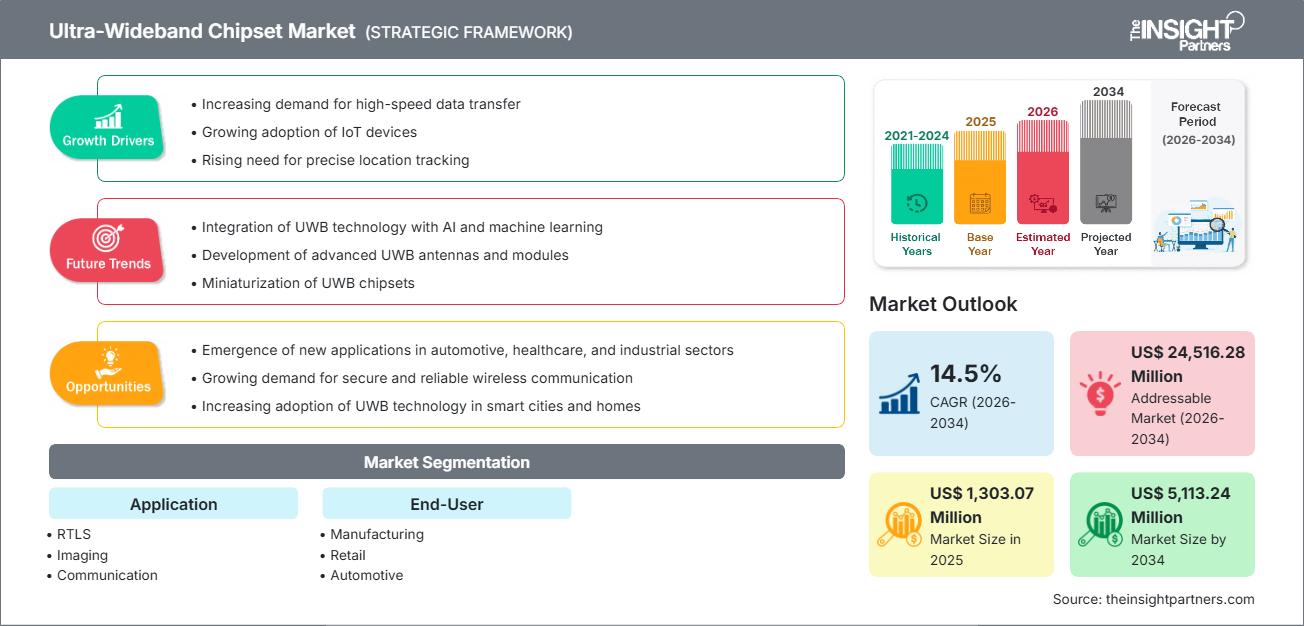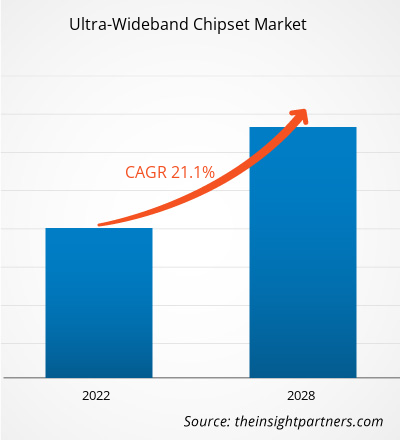Il mercato dei chipset a banda ultralarga è stato valutato a 1.303,07 milioni di dollari USA nel 2025 e si prevede che raggiungerà i 5.113,24 milioni di dollari USA nel 2034, con un CAGR del 14,5% dal 2026 al 2034.
Analisi del mercato dei chipset a banda ultralarga
Si prevede che il mercato dei chipset a banda ultralarga (UWB) crescerà notevolmente, grazie alla crescente adozione della tecnologia UWB nei sistemi di localizzazione in tempo reale (RTLS), alla domanda di tracciamento delle risorse ad alta precisione e all'integrazione della UWB nei dispositivi consumer e industriali.
La tecnologia UWB offre maggiore precisione, larghezza di banda più ampia, minore consumo energetico e migliore resistenza alle interferenze rispetto agli approcci RTLS tradizionali (ad esempio, RFID, posizionamento basato su Wi-Fi), il che la rende interessante per applicazioni che richiedono un posizionamento preciso in ambienti interni/esterni e una comunicazione sicura.
Inoltre, la crescita dell'IoT, dei dispositivi intelligenti, dell'elettronica indossabile, delle applicazioni automobilistiche (ad esempio, accesso sicuro, localizzazione dei veicoli) e dell'automazione industriale, tutti settori che traggono vantaggio dai chipset UWB, sta alimentando la domanda.
Panoramica del mercato dei chipset a banda ultralarga
I chipset a banda ultralarga sono circuiti integrati che consentono la comunicazione UWB, una tecnologia wireless che utilizza un ampio spettro di frequenze per la trasmissione e la misurazione di dati a corto raggio, ad alta precisione e a basso consumo. Questi chipset sono fondamentali per abilitare sistemi di localizzazione in tempo reale (RTLS) precisi, controllo degli accessi sicuro, comunicazione tra dispositivi e altri casi d'uso nei settori dell'elettronica di consumo, automobilistico, industriale, sanitario e della vendita al dettaglio.
Grazie alla precisione di localizzazione a livello centimetrico, alla bassa latenza, alla resistenza alle interferenze e alle comunicazioni a basso consumo energetico, i chipset UWB aiutano i produttori di dispositivi e gli integratori di sistemi a fornire prestazioni affidabili, sia per il monitoraggio delle risorse in un magazzino, sia per abilitare la consapevolezza spaziale degli smartphone, sia per garantire un accesso sicuro senza chiave nelle automobili.
Con la continua crescita della domanda di posizionamento preciso, tracciamento in tempo reale e comunicazioni sicure, i chipset UWB stanno emergendo come componenti infrastrutturali critici in diversi settori verticali.
Personalizza questo report in base alle tue esigenze
Riceverai la personalizzazione gratuita di qualsiasi report, incluse parti di questo report, analisi a livello nazionale, pacchetto dati Excel e potrai usufruire di fantastiche offerte e sconti per start-up e università.
Mercato dei chipset a banda ultralarga: approfondimenti strategici

-
Scopri le principali tendenze di mercato di questo rapporto.Questo campione GRATUITO includerà analisi dei dati, che spaziano dalle tendenze di mercato alle stime e alle previsioni.
Driver e opportunità del mercato dei chipset a banda ultralarga
Fattori trainanti del mercato:
- Esigenze di localizzazione e tracciamento ad alta precisione: la domanda di sistemi di localizzazione in tempo reale (RTLS) accurati nei settori della produzione, della logistica, della vendita al dettaglio, dell'assistenza sanitaria e delle infrastrutture intelligenti è in aumento, favorendo l'adozione della tecnologia UWB rispetto ad alternative meno precise.
- Crescente integrazione nell'elettronica di consumo e nei dispositivi intelligenti: con la proliferazione di smartphone, dispositivi indossabili, dispositivi per la casa intelligente e gadget IoT, i chipset UWB vengono sempre più integrati per consentire la consapevolezza spaziale, la comunicazione sicura e le funzionalità basate sulla prossimità.
- Applicazioni automobilistiche in crescita: la tecnologia UWB viene sfruttata per funzioni di accesso sicuro alle auto, localizzazione e comunicazione, contribuendo ad aumentare la domanda di chipset da parte dei produttori di automobili.
- Richiesta di comunicazioni a basso consumo e resistenti alle interferenze: i vantaggi intrinseci dell'UWB, la bassa latenza, la resistenza a multipath/interferenze e l'efficienza energetica, la rendono adatta ai moderni sistemi wireless che necessitano di affidabilità e precisione.
Opportunità di mercato:
- Espansione in diversi settori e casi d'uso di tecnologie emergenti: con la crescente domanda nei settori della logistica, della produzione intelligente, del monitoraggio delle risorse sanitarie, della gestione dell'inventario al dettaglio e dell'automazione intelligente di case e uffici, si prevede un'ampia adozione dei chipset UWB.
- Proliferazione di IoT e dispositivi intelligenti: con l'espansione globale degli ecosistemi IoT, l'integrazione di chipset UWB in più dispositivi offre un potenziale di crescita considerevole, anche nei dispositivi indossabili, negli smart tag e nella comunicazione tra dispositivi.
- Innovazioni nel settore automobilistico e della mobilità: l'impiego della tecnologia UWB nell'accesso ai veicoli, nella comunicazione sicura e nella localizzazione suggerisce importanti opportunità per i fornitori di chipset che collaborano con gli OEM del settore automobilistico.
- Migrazione dalle tecnologie di tracciamento/comunicazione legacy: poiché le aziende e i consumatori richiedono maggiore precisione e sicurezza, l'UWB si propone come sostituto dei sistemi più vecchi (ad esempio RFID, Bluetooth di base), favorendo l'adozione dei chipset.
Analisi della segmentazione del mercato dei chipset a banda ultralarga
Per applicazione:
- Sistemi di localizzazione in tempo reale (RTLS)
- Imaging
- Comunicazione
Per utente finale/settore verticale:
- Produzione
- Vedere al dettaglio
- Automobilistico
- Assistenza sanitaria
- Elettronica di consumo
Per geografia:
- America del Nord
- Europa
- Asia Pacifico
- America meridionale e centrale
- Medio Oriente e Africa
Approfondimenti regionali sul mercato dei chipset a banda ultralarga
Le tendenze e i fattori regionali che hanno influenzato il mercato dei chipset a banda ultralarga durante il periodo di previsione sono stati ampiamente spiegati dagli analisti di The Insight Partners. Questa sezione illustra anche i segmenti e la distribuzione geografica del mercato dei chipset a banda ultralarga in Nord America, Europa, Asia-Pacifico, Medio Oriente e Africa, America meridionale e centrale.
Ambito del rapporto sul mercato dei chipset a banda ultralarga
| Attributo del report | Dettagli |
|---|---|
| Dimensioni del mercato nel 2025 | 1.303,07 milioni di dollari USA |
| Dimensioni del mercato entro il 2034 | 5.113,24 milioni di dollari USA |
| CAGR globale (2026 - 2034) | 14,5% |
| Dati storici | 2021-2024 |
| Periodo di previsione | 2026-2034 |
| Segmenti coperti |
Per applicazione
|
| Regioni e paesi coperti |
America del Nord
|
| Leader di mercato e profili aziendali chiave |
|
Densità degli operatori del mercato dei chipset a banda ultralarga: comprendere il suo impatto sulle dinamiche aziendali
Il mercato dei chipset a banda ultralarga è in rapida crescita, trainato dalla crescente domanda degli utenti finali, dovuta a fattori quali l'evoluzione delle preferenze dei consumatori, i progressi tecnologici e una maggiore consapevolezza dei vantaggi del prodotto. Con l'aumento della domanda, le aziende stanno ampliando la propria offerta, innovando per soddisfare le esigenze dei consumatori e sfruttando le tendenze emergenti, alimentando ulteriormente la crescita del mercato.

- Ottieni una panoramica dei principali attori del mercato dei chipset a banda ultralarga
Analisi della quota di mercato dei chipset a banda ultralarga per area geografica
Secondo il rapporto di The Insight Partners, nel 2021 la presenza regionale del mercato ha riguardato Nord America, Europa, Asia-Pacifico, America Latina, Medio Oriente e Africa.
Storicamente, la regione Asia-Pacifico ha detenuto una quota sostanziale di fatturato (prima tra le regioni), seguita dal Nord America e dall'Europa.
Si prevede che la crescita nelle diverse regioni varierà a seconda dei tassi di adozione della tecnologia, dell'industrializzazione, della penetrazione dell'elettronica di consumo, dell'integrazione automobilistica e dello sviluppo delle infrastrutture IoT, offrendo un potenziale particolare nella regione Asia-Pacifico e nelle economie emergenti.
Panorama competitivo e densità dei giocatori
Il mercato dei chipset a banda ultralarga è caratterizzato dalla presenza di molteplici attori globali e sviluppatori di chipset di nicchia. Questi fornitori si differenziano per:
- Integrazione di chipset UWB in circuiti integrati versatili per dispositivi consumer e IoT.
- Progettazione avanzata del chipset che ottimizza potenza, larghezza di banda e resistenza alle interferenze.
- Collaborazioni strategiche con produttori di dispositivi (smartphone, OEM del settore automobilistico, produttori di apparecchiature industriali) per integrare la tecnologia UWB nei prodotti di nuova generazione.
- Innovazione volta a personalizzare l'UWB per applicazioni RTLS, di comunicazione e di imaging in diversi settori verticali.
Principali aziende operanti nel mercato dei chipset a banda ultralarga
- ALEREON, Inc.
- Apple Inc.
- Bespoon SAS
- Decawave Limited
- TAIYO YUDEN CO., LTD.
- Johanson Technology, Inc.
- NOVELDA AS
- NXP Semiconductors NV
- Pulse-Link, Inc.
Altri attori analizzati nel corso della ricerca sono:
- Texas Instruments Incorporated
- STMicroelectronics NV
- Samsung Electronics Co., Ltd.
- Zebra Technologies Corporation
- Sony Corporation
- Infineon Technologies AG
- Murata Manufacturing Co., Ltd.
- LitePoint Corporation
- Sewio Networks sro
- Nanotron Technologies GmbH
Notizie e sviluppi recenti sul mercato dei chipset a banda ultralarga
- Il rapporto globale di The Insight Partners conferma la forte crescita: si prevede che il mercato dei chipset UWB raggiungerà i 1.906,46 milioni di dollari entro il 2028.
- La crescente implementazione della tecnologia UWB nei settori RTLS, dei dispositivi consumer e dell'automotive è considerata un fattore chiave di crescita, grazie alla maggiore precisione della tecnologia UWB e alla sua capacità di sostituire i sistemi di tracciamento/comunicazione tradizionali.
Copertura e risultati del rapporto sul mercato dei chipset a banda ultralarga
Il rapporto "Dimensioni e previsioni del mercato dei chipset a banda ultralarga (2021-2034)" di The Insight Partners offre:
- Dimensioni e previsioni dettagliate del mercato a livello globale, regionale e nazionale per i segmenti chiave.
- Analisi delle tendenze del mercato, dei fattori di crescita, delle opportunità e delle dinamiche di mercato sottostanti.
- Segmentazione per applicazione, utente finale e area geografica.
- Panorama competitivo e profili aziendali per i principali fornitori di chipset.
- Analisi storica (2 anni), anno base, previsione (7 anni) con CAGR
- Analisi PEST e SWOT
- Valore/volume delle dimensioni del mercato - Globale, Regionale, Nazionale
- Industria e panorama competitivo
- Set di dati Excel
Report recenti
Testimonianze
Motivo dell'acquisto
- Processo decisionale informato
- Comprensione delle dinamiche di mercato
- Analisi competitiva
- Analisi dei clienti
- Previsioni di mercato
- Mitigazione del rischio
- Pianificazione strategica
- Giustificazione degli investimenti
- Identificazione dei mercati emergenti
- Miglioramento delle strategie di marketing
- Aumento dell'efficienza operativa
- Allineamento alle tendenze normative






















 Ottieni un campione gratuito per - Mercato dei chipset a banda ultralarga
Ottieni un campione gratuito per - Mercato dei chipset a banda ultralarga